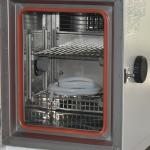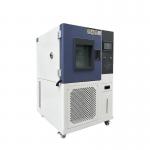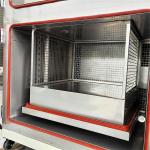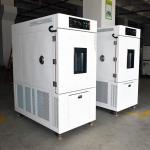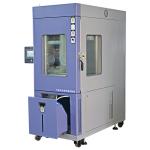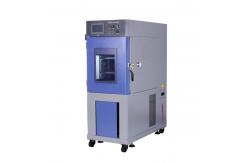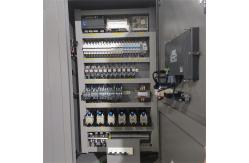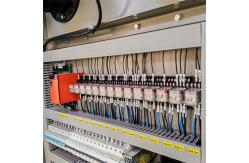In the highly competitive and quality-driven global marketplace,
ensuring the durability and reliability of products is
non-negotiable. The Climate Simulation Precision Temperature
Humidity Chamber emerges as a linchpin in the realm of quality
control and product durability testing, offering a meticulously
controlled environment that replicates a diverse range of climatic
conditions. This state-of-the-art chamber is purpose-built to subject products
to precise temperature and humidity variations, thereby simulating
the real-world environmental stresses they may encounter during
their lifecycle. It serves as an essential tool for industries
spanning from electronics and automotive to pharmaceuticals and
consumer goods. The primary objective is to evaluate the
performance, durability, and integrity of products under different
climatic scenarios. By doing so, manufacturers can identify
potential weaknesses, optimize product designs, and validate that
their offerings meet or exceed the stringent quality and durability
standards demanded by consumers and regulatory bodies. - Robust and Insulated Construction
- The chamber is constructed with heavy-duty materials that ensure
structural integrity and durability. The exterior is typically made
of corrosion-resistant steel, providing a sturdy shell that can
withstand the rigors of continuous use and the environmental
conditions of a testing facility. The interior is lined with a
non-reactive and smooth surface, such as stainless steel or a
specialized polymer, to prevent any interaction between the chamber
and the tested products. High-quality insulation is incorporated to
minimize heat transfer and maintain precise temperature and
humidity levels. The door of the chamber is engineered for a tight
seal, featuring a reliable locking mechanism and a heavy-duty
gasket. It is also equipped with a large viewing window, usually
made of tempered glass with anti-fog and anti-scratch properties,
allowing for continuous visual monitoring of the testing process
without compromising the internal environment.
- Precision Environmental Control Systems
- Temperature Control: The temperature control system is highly
accurate and can maintain a wide temperature range, typically from
-60°C to +150°C, with an accuracy of ±0.3°C. It utilizes advanced
refrigeration and heating technologies, along with a sophisticated
feedback loop and multiple temperature sensors strategically placed
throughout the chamber. This ensures uniform temperature
distribution and rapid temperature change capabilities, essential
for simulating extreme cold and hot conditions. The system also
incorporates safety features to prevent overheating or overcooling,
safeguarding both the products and the chamber itself.
- Humidity Control: The humidity control system is equally precise,
capable of adjusting the relative humidity from 5% to 95% RH, with
an accuracy of ±2% RH. The chamber is equipped with a
high-efficiency humidifier and dehumidifier, which work in tandem
to achieve rapid and accurate humidity adjustments. Special care is
taken to prevent condensation, which could potentially damage the
tested products or affect the accuracy of the test results. The
system also includes a dew point control function, which is crucial
for maintaining the integrity of the internal climate.
- Programmability: The chamber's control panel is highly
programmable, enabling users to create and store complex
temperature and humidity profiles. This allows for the simulation
of a wide variety of climatic conditions, from simple static
settings to intricate cyclic and stepwise changes. For example, it
can mimic the diurnal temperature and humidity fluctuations in a
tropical rainforest or the extreme temperature swings in a desert
environment. The control panel is user-friendly and intuitive,
displaying real-time information about the current temperature,
humidity, and the status of the testing program.
- Advanced Instrumentation and Data Acquisition
- The chamber is outfitted with a comprehensive suite of sensors.
Temperature sensors are distributed evenly to detect any
temperature gradients and ensure a homogeneous thermal environment.
Humidity sensors provide real-time data on the relative humidity
levels. These sensors are connected to a state-of-the-art data
acquisition system that records and stores all the measured data.
The data can be accessed and analyzed in real-time or retrieved
later for in-depth studies. The data acquisition system is highly
flexible and can be integrated with external software and
databases, facilitating seamless data transfer and analysis. It can
also be configured to send notifications and reports automatically,
saving time and effort for the users. Additionally, the control
panel includes built-in alarms and safety features that alert users
in case of any abnormal conditions, such as temperature or humidity
excursions outside the set limits, power failures, or equipment
malfunctions.
- Volume and Dimensions: The chamber is available in a variety of sizes to accommodate
different product dimensions and testing requirements. It can range
from compact benchtop models with a few cubic feet of volume to
large walk-in chambers that can house entire assemblies or multiple
samples. The interior dimensions are carefully designed to optimize
the distribution of temperature and humidity, ensuring that all
parts of the tested products are exposed to consistent conditions.
The external dimensions are also configured to fit within the
available space in a laboratory or production facility, taking into
account factors such as access, ventilation, and clearance.
- Temperature Range: As mentioned, the chamber can operate from -60°C to +150°C. This
extensive range is crucial for testing a wide array of products.
For instance, in the aerospace industry, components need to be
tested under extreme cold conditions to simulate the environment at
high altitudes and in space. In the electronics industry, it can
evaluate the performance of components and devices under both low
and high-temperature stress, ensuring their reliability in
different operating environments.
- Humidity Range: The relative humidity can be adjusted from 5% to 95% RH. In the
pharmaceutical and cosmetic industries, products may be sensitive
to different humidity levels. High humidity can affect the
stability and potency of drugs, while low humidity can cause drying
and cracking of cosmetic products. In the food industry, humidity
plays a significant role in determining the shelf life and quality
of perishable goods.
- Uniformity and Stability: The temperature uniformity within the chamber is maintained
within ±0.5°C, ensuring that all parts of the tested products
experience a consistent thermal environment. The humidity
uniformity is within ±3% RH. The stability of both temperature and
humidity is excellent, with minimal fluctuations over time,
allowing for accurate and repeatable testing.
- Accurate Simulation of Climatic Conditions
- The primary function of this chamber is to provide a highly
accurate and realistic simulation of specific temperature and
humidity conditions. By precisely controlling these parameters, it
allows manufacturers to evaluate how products will behave in
various real-world situations. For example, in the automotive
industry, it can test the durability of interior components under
different temperature and humidity conditions, ensuring that they
do not fade, warp, or deteriorate over time. In the electronics
industry, it can assess the performance of circuit boards and
components in humid and hot environments, identifying potential
issues such as corrosion or short circuits.
- The ability to create complex environmental profiles, such as
cyclic temperature and humidity changes, is also a valuable
function. This can help in uncovering potential weaknesses or
failure points in products that may not be evident under static
conditions. For instance, a product that is exposed to daily
temperature and humidity cycles may experience stress-induced
damage over time, and this chamber can accurately replicate such
scenarios.
- Enhanced Product Quality and Durability
- Through comprehensive testing in the chamber, manufacturers can
identify and address potential issues in their products. If a
product shows signs of degradation under specific climatic
conditions, the company can make design changes, select different
materials, or improve manufacturing processes to enhance its
resistance. This leads to the development of more stable and
reliable products, reducing the risk of in-field failures and
product recalls. It also helps in optimizing product warranties and
service intervals, as manufacturers have a better understanding of
the product's durability under different environmental stressors.
- The test chamber also serves as a powerful tool for research and
development. It allows engineers and scientists to study the
effects of temperature and humidity on new materials and product
designs. For example, in the field of materials science, the
chamber can be used to investigate the phase transitions and
mechanical properties of materials under different climatic
conditions, leading to the discovery of new materials with improved
performance and durability.
- Compliance with Industry Standards and Regulations
- Many industries have strict standards and regulations regarding
product testing in specific environmental conditions. The Climate
Simulation Precision Temperature Humidity Chamber is a reliable
tool for ensuring compliance. In the pharmaceutical industry,
products must meet certain temperature and humidity requirements to
ensure their safety and efficacy. By using this chamber to conduct
tests in accordance with relevant standards like ICH, USP, or GMP,
manufacturers can prove that their products meet the necessary
criteria, facilitating market access and enhancing consumer
confidence. Similarly, in the automotive and electronics
industries, compliance with environmental testing standards is
essential for product certification and marketability. Regulatory
bodies rely on accurate test results obtained from such chambers to
enforce safety and quality regulations.
|
